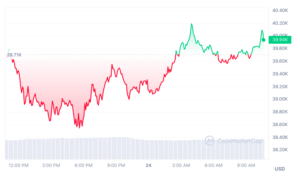Examining the recent decline in Bitcoin price, we’ll delve into market dynamics and consider what may come next.
Bitcoin’s price has been volatile since its inception in 2009, with notable peaks and troughs. It reached a high point in April 2021, nearing $65,000, and a low point in March 2020, falling below $4,000.
In January 2024, Bitcoin experienced a downturn after peaking at $49,000 over 20 months, dropping below $40,000 and settling around $35,000. This suggests a significant price adjustment, trading below $40,000, following its initial surge beyond $48,000 after the SEC’s approval of 11 new Bitcoin ETFs.
Currently, Bitcoin has taken a negative turn, declining by up to 20% from January’s peaks, with a 6% drop in the past two days, settling at $39,000.
Current Bitcoin Price Status
As of the latest update, the price of Bitcoin (BTC) is $39,676.64, accompanied by a 24-hour trading volume of around $30 billion. Experiencing a 0.93% decrease in the last 24 hours, Bitcoin maintains its position at the top on CoinMarketCap, boasting a market capitalization exceeding $777 billion. With a circulating supply of approximately 19 million coins, Bitcoin’s maximum supply is capped at 21 million BTC coins. At the time of writing, BTC is actively trading at $39,919.18.

Price Chart of Bitcoin (BTC): Source – CoinMarketCap
Factors Behind Bitcoin’s Recent Price Decline
1. Spot BTC ETF Launch Disappointment: The recent downturn in Bitcoin’s price can be attributed to the lackluster performance of the newly launched spot BTC exchange-traded funds (ETFs) in the United States. Despite high expectations within the crypto community, the ten new ETFs collectively attracted only $4.7 billion. The situation was further exacerbated by Grayscale’s substantial deposit of over $600 million worth of BTC on Coinbase and the now-bankrupt FTX’s sale of nearly $1 billion worth of GBTC shares. As the excitement surrounding spot ETFs diminished, crypto investors engaged in profit-taking, contributing to a significant drop in Bitcoin’s price over the past two weeks. Notably, Bitcoin skeptic Peter Schiff sees the failure of spot BTC ETFs to meet expectations as a key driver of the decline.
2. Wave of Liquidations: The recent price shift in Bitcoin, often described as a ‘massive liquidation,’ occurs when a considerable number of traders are forced to close their positions due to factors like margin calls or stop-loss orders. This results in increased selling pressure on Bitcoin, as more supply enters the market while demand decreases. Coinglass data reveals over $52.8 million in long positions liquidated in the last 24 hours, with cross-crypto long liquidations exceeding $23 million. Long liquidations surpassed $100 million in just one hour, according to data from Arkham Intelligence.

Source: Coinglass
Analysts attribute this decline to GBTC liquidations by bankruptcy estates, such as FTX, which sold nearly $1 billion worth of bitcoins. Additionally, profit-taking activities by major investors and a prevailing bearish sentiment among everyday investors contribute to the overall market downturn.
Bitcoin’s Near-Term Outlook and Future Catalysts
Analysts are cautioning that Bitcoin might face further declines in the latter part of the week if buying demand doesn’t swiftly recover, potentially breaching the $34,000 mark by the end of the month. The disappointment surrounding the performance of spot exchange-traded funds (ETFs) has provided an easier exit for long-term Bitcoin holders, contributing to the recent downward trend in prices.
Moving forward, experts emphasize that the future trajectory of Bitcoin’s price hinges on the ability of bullish investors to generate momentum around the current price levels, hovering near $40,000. Failure to secure this momentum might result in a return to the $38,000 range, according to some forecasts. Despite the recent market turbulence, there is optimism that the selling pressure related to ETFs will alleviate, potentially paving the way for a more stabilized upward trend.
Furthermore, the upcoming Bitcoin halving event scheduled for April 2024 is anticipated to have a positive impact on the cryptocurrency’s price. Historical patterns observed in previous halving events suggest that this could introduce a new dynamic to Bitcoin’s market dynamics, potentially influencing its price in the months to come.
Important: Please note that this article is only meant to provide information and should not be taken as legal, tax, investment, financial, or any other type of advice.
Join Cryptos Headlines Community
Follow Cryptos Headlines on Google News













